JMS-S3000 SpiralTOF™-plus 2.0 Matrix-Assisted Laser Desorption/Ionization Time-of-Flight Mass Spectrometer Model:JMS S3000 MALDI-TOF
The JMS-S3000 has evolved into SpiralTOF™-plus 2.0 with much wider dynamic range. The JMS-S3000 defines a new standard in MALDI-TOFMS performance and provides state-of-the-art analytical solutions for a wide range of research areas such as functional synthetic polymers, materials science, and biomolecules.

-
∎ Features
Setting the new standard in MALDI-TOFMS performance
To improve the mass resolving power and mass accuracy of a time-of-flight mass spectrometer, the flight distance must be extended while keeping a group of ions having the same m/z (an ion packet) from diverging in space.
The innovative SpiralTOF ion optics was developed by JEOL based on the "Perfect focusing" and "Multi-turn" principles. The ion packets are focused back in space at every fixed distance (i.e., each figure-eight trajectory) during the flight. Thus, even after the extended flight distance, the ion packets do not diverge at the detection plane, achieving high mass resolving power, high mass accuracy, and high ion transmission.


Reduced topographic effect of matrix crystalThe topographic effect of the matrix crystal leads to a difference in flight start position for the ions, resulting in a difference in flight time. In the conventional ion optical system, this time difference degrades the mass resolving power and also the mass accuracy obtained with external mass calibration. With its extended flight distance, the JMS-S3000 reduces this effect to the minimum and achieves highly reproducible mass resolving power and high mass accuracy with an external mass calibration. High mass-resolution and mass accuracy can be maintained for imaging analysis of a biological specimen in which a large number of mass spectra are acquired across a large area and the specimen surface is likely to be uneven.
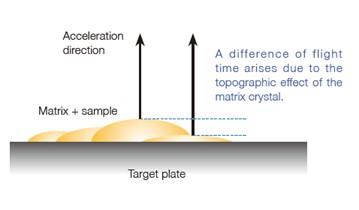
Achieving a wide dynamic range
The SpiralTOF™-plus 2.0 has realized a wide dynamic range by greatly improving the detection system. This makes it possible to simultaneously detect peaks with ion intensity differences of about 4 orders of magnitude. Also, the analysis of trace components has become easy in mass spectrometry imaging measurements, in addition to the conventional bulk sample measurements. Below is the measurement example of a mixture of polyethylene oxide and polypropylene oxide in the ratio of 1,000:1. In the case of polymer analysis, when combined with the Kendrick Mass Defect (KMD) analysis, it is possible to analyze trace components that are otherwise difficult to detect.
The mass spectrum of a mixture of polyethylene oxide and polypropylene oxide in the ratio of 1,000:1
The SpiralTOF™-plus 2.0 can realize a wide dynamic range and calculate the molecular weight distribution of trace components.

Features and usages of TOF-TOF option and linear TOF option
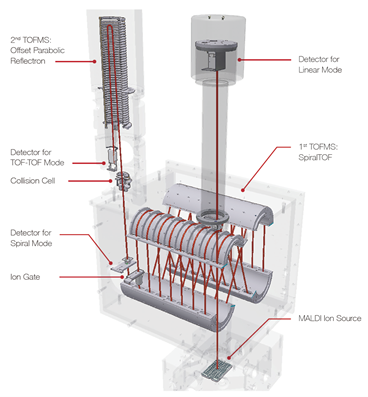 TOF-TOF option
TOF-TOF option- By adopting the SpiralTOF ion optics as the first MS, the high precursor ion selectivity can be realized. The monoisotopic peak of precursor ions can be properly selected.
- High-energy collision-induced dissociation (HE-CID) allows for the acquisition of product ion mass spectrum rich with structural information.
- Off set parabolic reflectron, JEOL's patented technology, enables acquisition of all product ion information from m/z 5 to the precursor ion, and facilitates to obtain structural information of high reliability.
UsageIndustrial polymeric materials based on mixtures of polymers with different end groups or copolymers contain a wide variety of compounds. It is necessary to detect all the components in order to grasp the whole picture, which requires ultra-high mass resolution in a wide mass range. In addition, it is important to detect not only the base material but also trace components because multiple types of polymers and trace additives are blended for higher functionality. With its wide dynamic range and ultra-high mass resolution over a wide mass range, SpiralTOF™-plus 2.0 is the solution that meets these requirements. Elimination of post source decay (PSD) derived ions, which is a major feature of SpiralTOF ion optics, also contributes significantly to clear mass spectrum analysis. We provide the most effective and unique solution for polymer analysis, which has become more and more complicated in recent years due to its high functionality and recycling.- In structural analysis of organic compounds, the accuracy of composition determination using accurate mass in Spiral mode can be improved by determining the adduct ion, in addition to the structural information obtained by HE-CID.
- In elucidation of amino acid sequences of a peptide, distinguishing structural isomers such as leucine and isoleucine is possible, as a feature of HE-CID. It is also possible to confirm the presence / absence of amino acids in a peptide by the presence / absence of immonium ions.
- For the analysis of additives, surfactants, and lipids, the structural analysis of alkyl chains is important. With HE-CID, it is possible to estimate the alkyl chain length and the positions of double bonds.
- For structural analysis of polymers, it is possible to confirm the ion type (adduct ion) and the mass of the end groups from the product ion mass spectrum. It is possible to improve the accuracy in structure elucidation in combination with the elemental composition estimation result with the Spiral mode.
__23L26tpDLM.png)
Linear TOF option- In the Linear TOF option, the ions travel from the ion source to the detector unaffected.
- When ions undergo post source decay (PSD) in flight, the produced fragment ions and neutrals continue to fly at the same velocity as before fragmentation. Hence, in a Linear mode mass spectrum, they are detected as the same signal as that of the ions that have not fragmented.
Therefore high molecular weight compounds that tend to undergo PSD can be measured with high sensitivity in the Linear mode. - The combination of Spiral and Linear modes further expands the range of analytes that can be measured.
Usage
- Useful for screening of molecular weight distribution of polymers.
- It is possible to calculate the molecular weight distribution & polydispersity of polymer samples with various masses ranging from several thousands to several tens of thousands.
- It is possible to measure high-mass samples of molecular weight over 10,000 Da such as intact proteins, with high sensitivity.
- It enables high-sensitivity measurement of samples that can easily undergo PSD, such as proteins and polysaccharides.
 40K, 100K, and 200K__23L26WnYLx.png)
msRepeatFinder: the Definitive Polymer Analysis Software (Option)
SpiralTOF™-plus 2.0 is Ideal for Polymer Analysis
Industrial polymeric materials based on mixtures of polymers with different end groups or copolymers contain a wide variety of compounds. It is necessary to detect all the components in order to grasp the whole picture, which requires ultra-high mass resolution in a wide mass range. In addition, it is important to detect not only the base material but also trace components because multiple types of polymers and trace additives are blended for higher functionality.
With its wide dynamic range and ultra-high mass resolution over a wide mass range, SpiralTOF™-plus 2.0 is the solution that meets these requirements.
Elimination of post source decay (PSD) derived ions, which is a major feature of SpiralTOF ion optics, also contributes significantly to clear mass spectrum analysis.
We provide the most effective and unique solution for polymer analysis, which has become more and more complicated in recent years due to its high functionality and recycling.
__23L268s6cL.png)
The SpiralTOF™-plus 2.0 achieves high mass resolving power over a wide mass range which is required for the analysis of polymers.
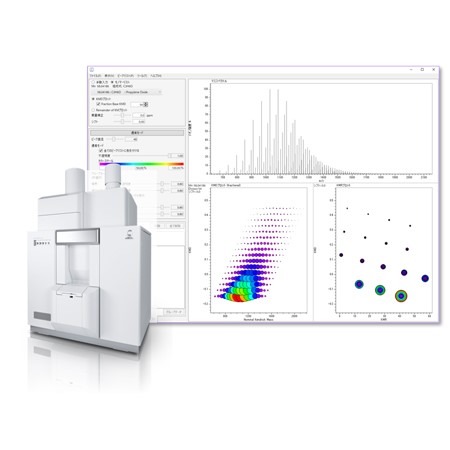
msRepeatFinder (Option)
The Kendrick Mass Defect (KMD) plot and the Kendrick Mass Remainder (KMR) plot are used to estimate the polymer species and end groups contained in polymer materials from a complex mass spectrum and clarify their identity. In addition, the differential analysis function between two samples is effective in verifying sample degradation, lot-to-lot differences, and differences in the synthesis process.
msRepeatFinder Polymer Analysis SoftwareEvolving mass imaging analysis
MALDI MS imaging was initially developed to focus on high molecular weight compounds such as proteins and peptides. However, with the expanding applications of MALDI MS imaging, the interests have shifted to include smaller molecules such as lipids, pharmaceuticals, and pharmaceutical metabolites. Conventional MALDI - reflectron TOFMS has difficulty discerning small molecule signals from those of matrix. In the case of MALDI MS imaging, signals from unwanted molecules on the specimen surface will often interfere with signals from the target analytes. High selectivity by means of high mass-resolving power is essential for obtaining reliable target analyte spatial distributions. It is also important to maintain high mass-resolution and mass-accuracy for a long time even when measuring a sample surface with a large area and non-uniformity.
SpiralTOF™-plus 2.0 is the only MALDI-TOFMS that meets imaging requirements with ultra-high mass-resolution and long flight distance to minimize loss of mass resolution due to sample surface non-uniformity. In addition, it also supports high-speed mass imaging analysis.Mass Spectrometry Imaging Analysis of Lipids in Mouse Brain Tissue Section
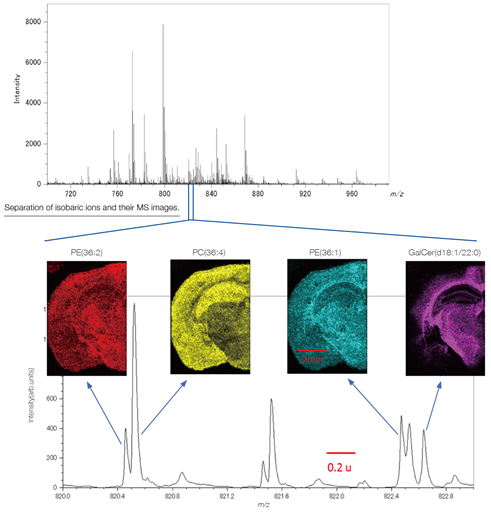 PE: Phosphatidyl ethanolamine, PC: Phosphatidyl Choline, GalCer: Galactosylceramide
PE: Phosphatidyl ethanolamine, PC: Phosphatidyl Choline, GalCer: Galactosylceramide
The data were acquired in a joint research project with the Mass Spectrometry Group, Project Research Center for Fundamental Sciences, Graduate School of Science, Osaka University.
The tissue section specimen was provided by Awazu laboratory, Division of Sustainable Energy and Environmental Engineering, Graduate School of Engineering, Osaka University.
Mass spectrometry imaging of polymers
Mass spectrometry imaging can be applied to polymers. Two spots are prepared by adding two antioxidants - Irgafos 168 (BASF) and Irganox 1010 (BASF) - to polymethylmethacrylate (PMMA). The ultraviolet irradiation was performed to the right spot only and its degradation was visualized by using mass spectrometry imaging. For polymers, it is possible to visualize the quantitative change in both polymers and additives. It is also possible to capture the changes in the average molecular weight and polydispersity.
JMS-S3000 SpiralTOF™-plus 2.0 Mass Spectrometry Imaging System (Option)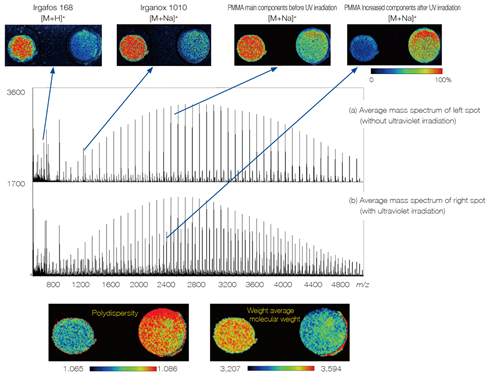
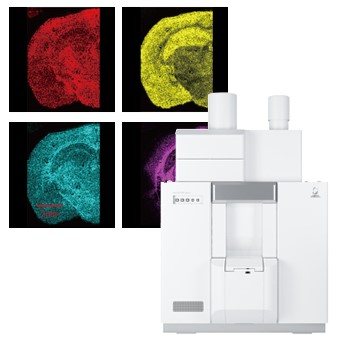
Analysis of proteins
For the detailed analysis of a protein, not only the intact protein but also enzymatic digest of the protein can be analyzed. Peptide mass fingerprinting allows identification of a protein.
Mass spectrum of the tryptic digest of bovine serum albumin (BSA) and the results of the peptide mass fingerprinting.
Mass spectrum of BSA tryptic digest standard (equivalent to 500 amol)

Amount (fmol) Number of peptides matched/searched Sequence coverage (%) MASCOT score 50 52/81 75 570 10 41/79 64 390 5 36/77 54 351 1 28/57 43 255 0.5 31/52 46 306 0.1 12/34 18 92 3D-structure of RCSB PDB (www.rcsb.org) ID 1IGY (Harris, L.J., et al. (1998) J.Mol.Biol. 275: 861-872) created with Protein Workshop (Moreland, et al. (2005) BMC Bioinformatics 6:21).Analysis of small molecules
Previously, MALDI-TOFMS systems were not suitable for the analysis of small molecules as matrix-derived peaks and continuous chemical noise interfere with the signal from analyte molecules. The SpiralTOF ion optics have solved these problems.
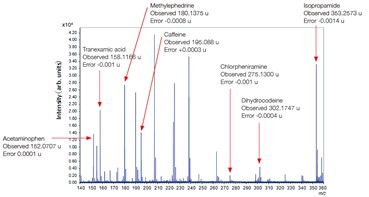
-
Items Specification Resolving power 60,000 (ACTH fragment 1-17[M+H]+: m/z 2093.1) Mass accuracy
(internal reference)1 ppm (average error) Mass accuracy
(external reference)10 ppm (average error) Sensitivity 500 amol, S/N > 50
with standard stainless steel plateLaser Wavelength 349 nm (maximum 250 Hz) -
- End-group analysis of polymers
- Analysis of an anionic surfactant
- Analysis of copolymers
- Differential analysis of 2 polymer samples
- Compositional analysis of an industrial surfactant
- Mass spectrometry imaging of polymers
- Surface analysis of polymeric materials
- Measurement of high molecular weight additives
- Deterioration analysis of an organic light-emitting diode panel
- Analysis of a common cold medicine( MSTips No. 241)
- Analysis of boroxin cage 12-mer
- Structural analysis of small molecules
- Measurement of the molecular weight of an intact protein by using linear









